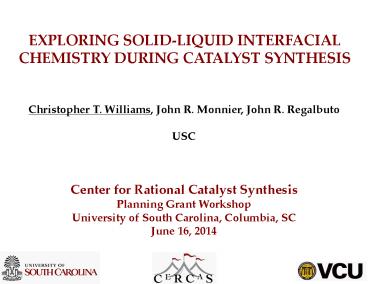EXPLORING SOLID-LIQUID INTERFACIAL CHEMISTRY DURING CATALYST SYNTHESIS - PowerPoint PPT Presentation
1 / 8
Title:
EXPLORING SOLID-LIQUID INTERFACIAL CHEMISTRY DURING CATALYST SYNTHESIS
Description:
EXPLORING SOLID-LIQUID INTERFACIAL CHEMISTRY DURING CATALYST SYNTHESIS ... adsorbed species can result in sintering of small nanoparticles due to enhanced ... – PowerPoint PPT presentation
Number of Views:130
Avg rating:3.0/5.0
Title: EXPLORING SOLID-LIQUID INTERFACIAL CHEMISTRY DURING CATALYST SYNTHESIS
1
EXPLORING SOLID-LIQUID INTERFACIAL CHEMISTRY
DURING CATALYST SYNTHESIS
Christopher T. Williams, John R. Monnier, John R.
Regalbuto USC
Center for Rational Catalyst Synthesis Planning
Grant Workshop University of South Carolina,
Columbia, SC June 16, 2014
2
Exploring Solid-Liquid Interfacial Chemistry
During Catalyst Synthesis
Research Team Williams, Monnier, Regalbuto
(USC) Overview Probe surface chemistry during
SEA and ED processes to facilitate optimization
of bimetallic catalyst synthesis
hn
Technical Information in-situ surface
vibrational (FTIR, Raman) spectroscopy
optimization of catalyst synthesis process.
Industrial Relevance Precise control of synthesis
3
Industrial Relevance
Producing Bimetallic Catalysts with Small
Particle Sizes
Minimize Metal Usage in Bimetallic Catalysts
4
Goals of the Proposal
- Use Attenuated Total Reflection Infrared (ATR-IR)
and Raman spectroscopies to explore surface
chemistry during ED and SEA synthesis of
bimetallic catalysts - Correlate surface speciation with ED and SEA
synthetic parameters and resulting catalyst
properties - Develop strategies to overcome limitations and
enhance performance of the approaches
5
Proposal Hypotheses
- Adsorption of chemical species from solution
plays key roles in ED - stabilizers reducing agents (e.g., formaldehyde,
DMAB, NaBH4), also in their oxidized forms and
their fragments, e.g., CO - varying extents/strengths of adsorption on
various metals helps to determine the selectivity
of autocatalytic vs. catalytic deposition - adsorbed species can result in sintering of small
nanoparticles due to enhanced mobility of atoms
(e.g., metal complexes) - The stability of surface oxides during sequential
SEA methods is a key determining factor in its
success - adsorption of precursors onto support and first
metal oxide can result in alteration of the oxide - formation of mixed oxides during the activation
treatment will effect eventual properties of
reduced bimetallic particles - Correlation of surface speciation (measured with
spectroscopy) and solution-phase parameters
(measured during synthesis) can be coupled to
generate predictive models
6
Research Methods/ Techniques
In-Situ ATR-IR and Raman of Support/Catalyst
Films in the Liquid Phase
In-Situ Raman During Gas-Phase Activation of
Catalysts
7
Outcomes/ Deliverables Year 1
- Mn-Rh/SiO2 synthesis by SEA explored by Raman
- Liquid-phase adsorption of MnO4- species onto
supported Rh2O3 under different solution-phase
conditions - Gas--phase calcination/reduction of
SiO2-supported MnO4-/MnO4-/Rh2O3 particles - Correlation of surface speciation with resulting
bimetallic particle structure - Ag-Pt/X (XSiO2,Al2O3) synthesis by ED explored
by ATR-IR - Adsorption/activation of reducing agents -
formaldehyde, hydrazine, dimethylamine borane -
on Pt catalysts, bare supports, and Pt metal - ED of AgNO3 onto Pt catalysts and Pt metal under
different conditions - Influence of adsorbed CO on the speciation during
ED process - Correlation of surface speciation with deposition
limits and sintering observed in batch and/or
continuous ED experiments - Longer Term Plans (beyond first year)
- Extension to other SEA/ED synthetic systems as
suggested by EAB - Development of predictive models based on surface
chemistry insight
8
Impact
- Improved understanding of surface chemical
factors that may hinder implementation of SEA and
ED in industry - Enhanced catalyst properties at reduced cost?
- Establishment of in-situ solid-liquid interface
techniques that can address needs of EAB members - ATR-IR can be applied to a broad range of
liquid-phase adsorption and reaction processes
relevant to catalytic materials synthesis
Duration of Project and Proposed Budget
- 1 year _at_ 60,000
- 60,000/yr thereafter, expanding to other systems
as desired































